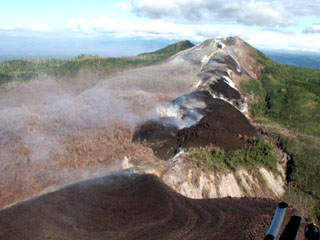Report on Witori (Papua New Guinea) — June 2008
Bulletin of the Global Volcanism Network, vol. 33, no. 6 (June 2008)
Managing Editor: Richard Wunderman.
Witori (Papua New Guinea) Ejection of lava fragments in late August 2007; quiet steaming
Please cite this report as:
Global Volcanism Program, 2008. Report on Witori (Papua New Guinea) (Wunderman, R., ed.). Bulletin of the Global Volcanism Network, 33:6. Smithsonian Institution. https://doi.org/10.5479/si.GVP.BGVN200806-252080
Witori
Papua New Guinea
5.5745°S, 150.5161°E; summit elev. 724 m
All times are local (unless otherwise noted)
Reports about Pago early in 2006 (BGVN 31:02) noted small vapor emissions, but no noises or glow, and low levels of seismicity. Similar observations were reported by the Rabaul Volcano Observatory (RVO) for December 2006. A local security company reported that sometime during 27-31 October 2006 there was a single booming noise accompanied by a white-gray emissions above the summit. Volcanologists were sent to verify the activity, but no report about the event was received. A March 2007 report only noted diffuse white vapor emissions and low seismicity.
On 28 August 2007 lava fragments were observed being ejected during the daytime from one of the Upper vents (2nd Crater). People in a nearby village heard only a single booming noise in the early hours of 27 August. The residents also indicated increased white vapor emissions from 2nd Crater on the 27th that returned to normal levels the following day. Seismic activity had increased on 27-28 August, and the Real-Time Seismic Amplitude Measurement (RSAM) increased from background level (around 100 units) to a peak of about 400 units. RSAM levels began to decline on the 29th, returning to background levels on 30 August. An inspection on 1 October revealed that only the 2nd Crater of the Upper Vents was releasing diffuse white vapor, and that there were no noises or glow.
Pago remained quiet during September-November 2007. When observations were made, only diffuse white vapor was being released from the Upper Vents. A handful of high-frequency earthquakes and 18 low-frequency events were recorded during September. The daily number of earthquakes ranged from 1 to 4 from 1 to 24 September, with none after through the end of the month. There was a slight increase in gas emission during 9-11 November. The vapor plume was blown N, where villagers reported nose and windpipe irritation, and watery eyes. The daily number of high-frequency earthquakes ranged from 1 to 3, while low-frequency earthquakes ranged from 1 to 9. During January 2008 Pago was still quiet with diffuse white vapor from the upper vents and very occasional low-frequency seismic events.
Geological Summary. The active Pago cone has grown within the Witori caldera (5.5 x 7.5 km) on the northern coast of central New Britain contains the active Pago cone. The gently sloping outer caldera flanks consist primarily of dacitic pyroclastic-flow and airfall deposits produced during a series of five major explosive eruptions from about 5,600 to 1,200 years ago, many of which may have been associated with caldera formation. Pago cone may have formed less than 350 years ago; it has grown to a height above the caldera rim, and a series of ten dacitic lava flows from it covers much of the caldera floor. The youngest of these was erupted during 2002-2003 from vents extending from the summit nearly to the NW caldera wall. The Buru caldera cuts the SW flank.
Information Contacts: Ima Itikarai and Herman Patia, Rabaul Volcano Observatory (RVO), P.O. Box 386, Rabaul, Papua New Guinea.

